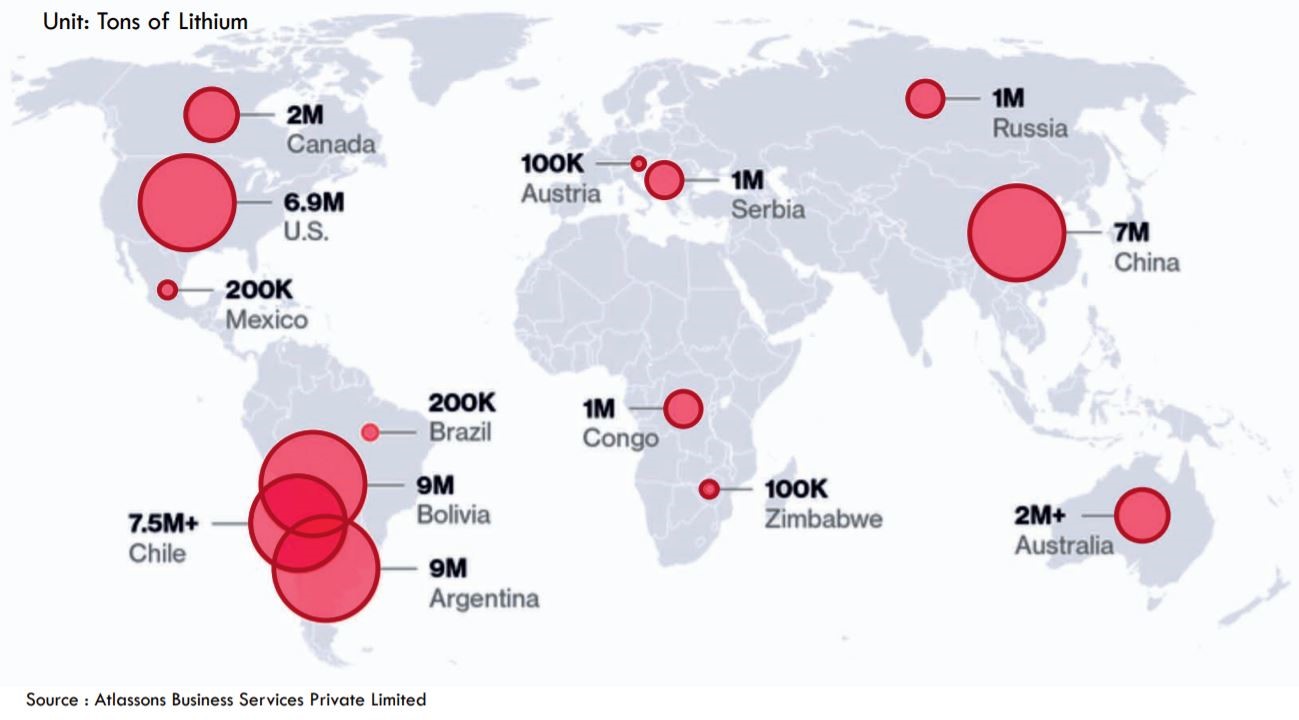17 Feb The Indian story of White Gold—a Lithium
The Indian story of White Gold—a Lithium
News of the recent exploration of 5.9 million tonnes of Lithium in the Salal- the Haimana area of the Reasi district of J & K has captured every Indian’s attention. The discovery is a landmark as the World is craving for in-demand minerals such as Lithium.
The discovery is validated by the Geological Survey of India (GSI), adding to lots of cheers. The report by GSI is the second in the four-stage exploration process that will lead to final and exact reserves.
What is Lithium?
It is a rare earth metal (REM), which is generally mainly silver-white in appearance. It is generally observed in the earth’s crustal part and obtained by the solar evaporation of a large brine pool.
The extraction of this metal is generally by Open pit mining which needs the removal of large overload on the surface.

Lithium
World distribution of Li-reserves
To date, the continent of South America is fortunate enough to have the largest reserves of white gold. The region known as the “Golden Triangle,” as in Argentina-Chile-Bolivia, is the current largest storehouse of the world’s reserves. The next significant reserves are in the Pilbara and Yilgarn cratons of Australia, which also host significant reserves.
Apart from these locations, China and the Korean Peninsula also host white metal reserves. Thanks to a new discovery, India is a new entrant in the top club (though India has small 16-tonne reserves in Karnataka found earlier).
But contrary to this, China is a major (77%) supplier of REM and lithium due to its excessive control over the global supply chain!

distribution of Li-reserves
The significance of lithium
- As of today, modern civilization is mainly coal- and petroleum-driven and has thus suffered much irreversible environmental damage. The solution that humanity sees is in the lithium-driven e-batteries that could drive the next generation of our civilization.
- Lithium is considered the tool for green economic transformation as its uses are diverse in renewable energy, such as solar panels, wind turbines, and electric batteries, which have started to change our environmental footprints.
- Lithium batteries are long-lasting with high energy density, are rechargeable, and with fewer carbon footprints.
- Metal also holds prominence as it forms an important element in industries as well.
- According to a World Bank report, demand for Li would rise by 500% by 2050.
What are the concerns about its use?
Though its metal for the world’s green transition but there are, equally, some concerns attached to its use as-
- The mining of Li, as mentioned, is open-pit, which leaves many scars on the surface. It involves the removal of overburden, i.e., vegetation, waterbodies, soil, etc. It also involves large-scale rehabilitation of the population and wildlife.
- The contamination of groundwater, the air release of harmful materials, the loss of biodiversity, and the lurching of the ground are major concerns.
- For India, the country with the most population and density the visible and invisible socio-economic impacts are more than other parts undergoing Li explorations.
What has this new discovery made possible for India?
If the inferred discovery would go stronger further India has a lot to gain from it.
- Green commitments: This would make it possible to fulfill India’s commitment to achieving 30% electric vehicles by 2030. This adds significantly to India’s credibility as the future green country.
- Export earnings: Li is the most sought-after mineral in the world. And we can earn an export advantage by entering the global supply chain.
- Employment: This discovery has the potential to create new employment and, in fact, alter the nature and role of the workforce in the near future.
- Geostrategic advantage: The most important advantage that policymakers tend to derive is to avoid dependency on China. Currently, India imports this crucial metal from China and Hong Kong. With its own reserves now, it can have its own domestic production and export earnings.
Way Forward
India needs to make sure the discovery is finally realized. There shouldn’t be gaps in the planning and exploration. Well-guided mining strategy with reliance on sustainable mining practices and most importantly, local involvement is much needed in the region like J&K. The green future, in the form of Li reserves, has knocked on the door of India, and it is our duty to grab the opportunity and achieve the desired results.
Source:
Daily Current Affairs for UPSC
PLUTUS IAS CURRENT AFFAIRS 17th FEB 2023
The UPSC aspirant acquires a broad knowledge of what is happening in the world through reading current affairs. They also gather a diversity of knowledge on the present incidents in India. The topic described above talks about the Indian Story of White Gold- Lithium. To obtain such kinds of the latest news, read the best daily current affairs from Plutus IAS for the UPSC examination. Also, get updated weekly and monthly current affairs today for IAS exam preparation.




No Comments